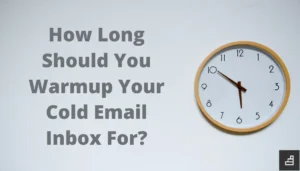
How to warm up an email domain (+ best practices)
Warming up a new domain is essential to keep your emails out of the spam folder and to improve your sender reputation.
In this article, you’ll find out how domain warm-up works and why it’s a necessary step before sending high volumes of emails. You’ll learn:
- Best practices so that your domain performs well and avoids deliverability issues
- The gradual process of warming up a domain to build trust with email service providers
- Key factors that influence your domain’s reputation and how to manage them
What is domain warm up?
Domain warm-up is a process of sending emails from a new (or cold) email domain and gradually increasing send volumes in order to establish a positive email reputation.
Why is domain warm up important?
The purpose of domain warm-up is to improve your domain reputation and gain ESPs’ trust so all your emails can be delivered right into recipients’ inboxes (and not be blocked by spam filters).
Whenever you start sending emails from a completely new email domain with zero reputation, ISPs and ESPs (Email Service Providers) can get suspicious about it and prevent your domain from delivering a larger number of messages at once until you “prove” that you are a reliable email sender.
Once ISPs have some historical data about your domain and your email activity, they will allow you to send more messages to a larger audience – or vice versa, throttle your email volumes if you start to have a bad domain reputation.
Domain warmup helps to create a positive email reputation for your new domain by gradually sending a larger and larger number of messages over several weeks until your domain is ready and properly “warmed up”.
| Note: It is important to understand that domain reputation is not the only factor that can impact your email deliverability. ISPs and ESPs also take into consideration the reputation of your IP address, subdomains, or even a specific email address when determining if or how many messages should be delivered to your recipients. |
What impacts domain reputation?
A domain’s reputation can be influenced by many factors such as:
- Delete rate – the number of recipients that moved your emails into their trash folder.
- Spam reports – the number of spam complaints that your domain receives.
- Unsubscribe requests – people who unsubscribed from your email list.
- Email content – the quality of your messages, usage of spam words, grammar mistakes, the trustworthiness of links (if included), etc.
- Engagement rate – the number of people who opened, replied to, or forwarded your emails.
- Blacklists – The reputation of a domain address can suffer if it is put on one of the popular email blacklists.
- Bounce rate – the number of emails that were not delivered to recipients’ inboxes.
- And many, many other factors…
It’s important, though, to understand that not all of these components carry the same weight.
For example, if some people unsubscribe from your email list, the domain reputation won’t change that much – on the other hand, having many spam reports can severely damage the reputation of your domain.

Email domain warming – best practices
Domain warmup involves a lot of activities that can slowly (but surely) improve your domain reputation over time.
Here are a few practices that you should keep in mind when warming up your email domains:
- Know your sending limits
- Implement email authentication
- Improve IP reputation
- Avoid spammy words
- Provide high-quality content
- Maintain regular conversations
- Clean your email lists
- Switch to a dedicated IP
- Use warm-up tool
1. Know your sending limits
Depending on the number of emails you want to send per day, you may want to look into upgrading your ESP.
We do not recommend sending email blasts from a free Gmail or Outlook account because scammers tend to use these and you will be flagged.
It’s also important to understand that many ESPs equate the “number of emails sent” with the “number of recipients.” In short, trying to circumvent the limits by BCC-ing all of your recipients on a single message won’t work.
Here’s a quick list of some of the most popular ESPs and their sending limits.
| Email Service Provider | Sending Limit (Per Day) |
|---|---|
| Gmail (Free) | 500 |
| Gmail (Google Workspace) | 2000 |
| Outlook (Free) | 300 |
| Microsoft 365/Office 365 | 10000 |
| Zoho (Free) | 50 |
| Zoho (Paid) | 300 |
| Zoho (Custom) | 2500 |
| GoDaddy | 250 |
| RackSpace | 10000 |
| Yahoo! | 500 |
| BlueHost | 150 (per hour) |
| DreamHost | 100 (per hour) |
| Yandex.mail | 500 |
| HostGator | 12000 |
| Amazon SES | 10000 |
| Proton Mail (Free) | 150 |
| Proton Mail (Plus) | 1000 |
| Proton Mail (Professional/Visionary) | unlimited |
| AOL | 500 |
| Mailgun | 300 |
| SendGrid (Free) | 100 |
| SendGrid (Essentials) | Up to 100,000 per month |
| SendGrid (Pro) | Up to 1.5 million per month |
| Sendpost (Starter) | 10,000 per month |
| Sendpost (Growth) | 600,000 per month |
| Sendpost (Scale) | 3 million per month |
2. Implement email authentication
Email authentication can indicate to ISPs that your domain is reliable and can be trusted.
Authentication allows receiving servers to quickly verify your emails and prevent hackers from spoofing your account.
It also shows that you prioritize your customers’ well-being and don’t want them to be flooded with spammy messages.
The email authentication consists of 3 parts (and it’s best to take the time to complete all of them):
- Sender Policy Framework (SPF) – A DNS record that allows you to specify authorized domains that can send messages on your behalf.
- Domain Keys Identified Mail (DKIM) – A DNS record that adds encryption to all of your outgoing emails so the servers can see that your email content hasn’t been tampered with.
- Domain-based Message Authentication, Reporting, and Conformance (DMARC) – A DNS protocol that uses both SPF and DKIM to assist ISPs when validating the authenticity of your emails.
3. Improve IP reputation
Having a positive IP reputation is as equally important as having a good domain one.
If your IP address gets a bad rep, all of your emails will be either blocked or simply end up in the spam folder – and your domain reputation will suffer along the way too.
ISPs are doing everything they can to protect their users from spam and malicious content, so if you have a less-than-stellar IP reputation, your emails might not get delivered to your subscribers.
4. Avoid spammy words
Spam filters are sensitive to the content that your emails contain, especially for risky words that just attract attention and mislead the readers.
Due to this fact, try to avoid words like “FREE”, “75% OFF”, “BUY RIGHT NOW”, etc., since it will just increase the chance that your emails will end up in spam folders.
The same can be applied to click-bait titles or claims in your emails that are promising some prize but in reality leading to something completely different.
Here is a list of spammy words that you should not include in your emails if you want to have a positive IP reputation (collected by Mailjet):

5. Provide high-quality content
Writing a good and relevant email copy does not probably need an explanation – if your email content seems like a scam, recipients won’t click on any of your promotion links (and probably won’t open your messages in the future ever again).
At the end of the day, with scammy content, you will probably get a lot of spam reports – which will hurt your domain warm-up process as well as your domain reputation overall.
Although creating a good email copy is a little bit of an art and requires some marketing skills, there are a few ways how you can improve your email content immediately:
- Personalize the message – whether it is the name or the location of the recipient, writing a personalized email will keep the reader engaged and more willing to read your full message.
- Keep the optimal length – depending on the type of your email, you might consider creating a shorter (or longer) version of your content. In cases like sales emails or lead generation, nobody likes to read tons of text (especially if it is just a reminder of some product promotion or discount). On the other hand, newsletters or marketing emails tend to have slightly longer content.
- Make it readable – try to keep sentences short and concise, divided into small paragraphs, and with an easy-to-read font that users can quickly scan.
6. Maintain regular conversations
Creating positive engagement and getting responses is a huge plus for your domain reputation – but that is just half of the work.
When getting answers to your messages, try to keep up the conversations flowing and reply to users who wrote you back.
Having regular conversations is a strong signal for email service providers that your email account is trustworthy – which leads to a quicker warmup of your email domain.
7. Clean your email lists
Regular cleaning of your email lists will help you save your resources as well as keep your open rates and CTRs high (since you will be keeping only email addresses that are used by real people).
Cleaning your email lists can also help you get rid of the users who simply are not interested in your content anymore (and probably won’t read your emails even after 5 or 10 email campaigns).
To get rid of invalid email addresses, spam traps, or soft bounces, you need to use tools like EmailListVerify that can automatically “catch” and delete these types of addresses for you.
Regular checking and cleaning of your email lists can help you to:
- Save money (and time) – with a “healthy” email list, you can be sure that your messages will be delivered to real people and won’t be wasted on error email addresses or bots.
- Protect your domain reputation – every email list can get some invalid email addresses, soft/hard bounces, or spambots from time to time. That’s why regular verification of emails in your list can protect your domain and IP reputation and keep them safe from unwanted email addresses
8. Switch to a dedicated IP
If you’re operating on a shared IP, you may want to consider transferring your information to a dedicated IP to have more control over your reputation.
Shared IP and its reputation can be negatively impacted by other people who are using it as well – even if you would try your best to properly warm up the IP address, the IP reputation could be easily damaged by spammers or scammers who would use the given IP for their malicious email activities.
Switching to a dedicated IP address will help you to solve this issue and give you full control over its reputation (+ domain reputation as well).
9. Use warm up tool
Warming up a new email domain is a pretty straightforward process but also very time-consuming: you have to prepare engaging content, keep up with conversations, and continuously send more and more emails over a long period of time.
That is why it is always a good idea to use tools that are capable of warming up inboxes for you, such as our Warmup Inbox tool.

Warmup Inbox is a pretty easy and straightforward tool – it sends out emails on your behalf, gets responses, creates engagement in email threads, etc. within our platform.
It contains hundreds of other email accounts that automatically communicate with each other.
Once your email account is synced with Warmup Inbox, there are a number of ways that our tool can help automate the process of building up your email reputation:
- Send and receive automatic emails – Warmup Inbox is capable of creating dynamic content that is sent and received within our platform.
- Pull out your emails from the spam folder – if some of your emails end up marked as spam by an ESP, Warmup Inbox will automatically pull those emails out from the spam folder and correct them as important messages (which will automatically improve the reputation of your email account).
- Monitor email blacklists – Warmup Inbox monitors all major email blacklists and constantly checks if any of the synched email accounts are not listed in some of them.
- Track your “health” score – Warmup Inbox tool will give you a clear overview of the sender health of your sender domain – it scores your account on a scale of 0 – 10 based on many factors that influence the email deliverability (e.g.blacklists, security protocols, the quality of your email message, etc.).
| Tip: If you are preparing a wide-scale email campaign, you can book a 30-minute free consultation. |



